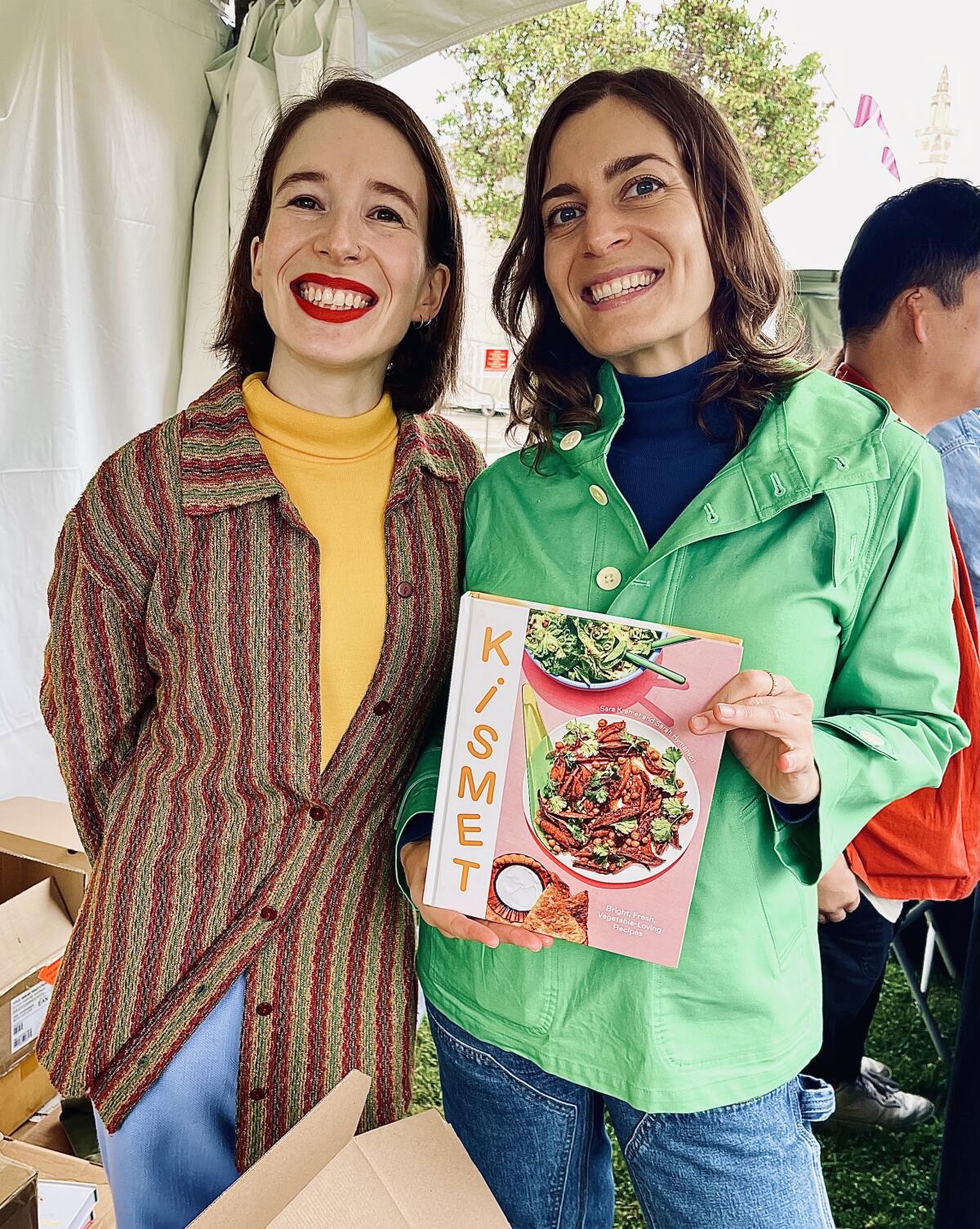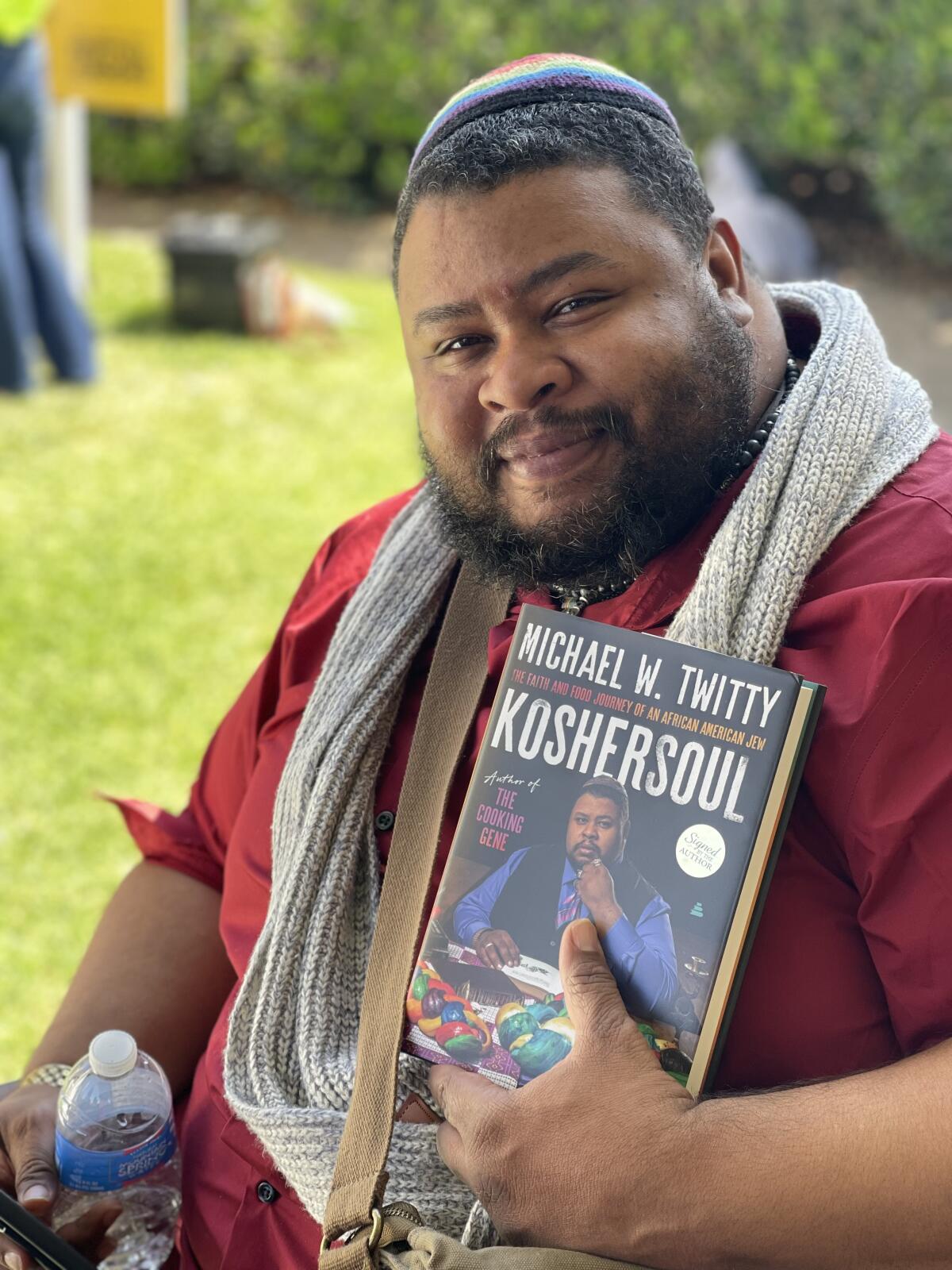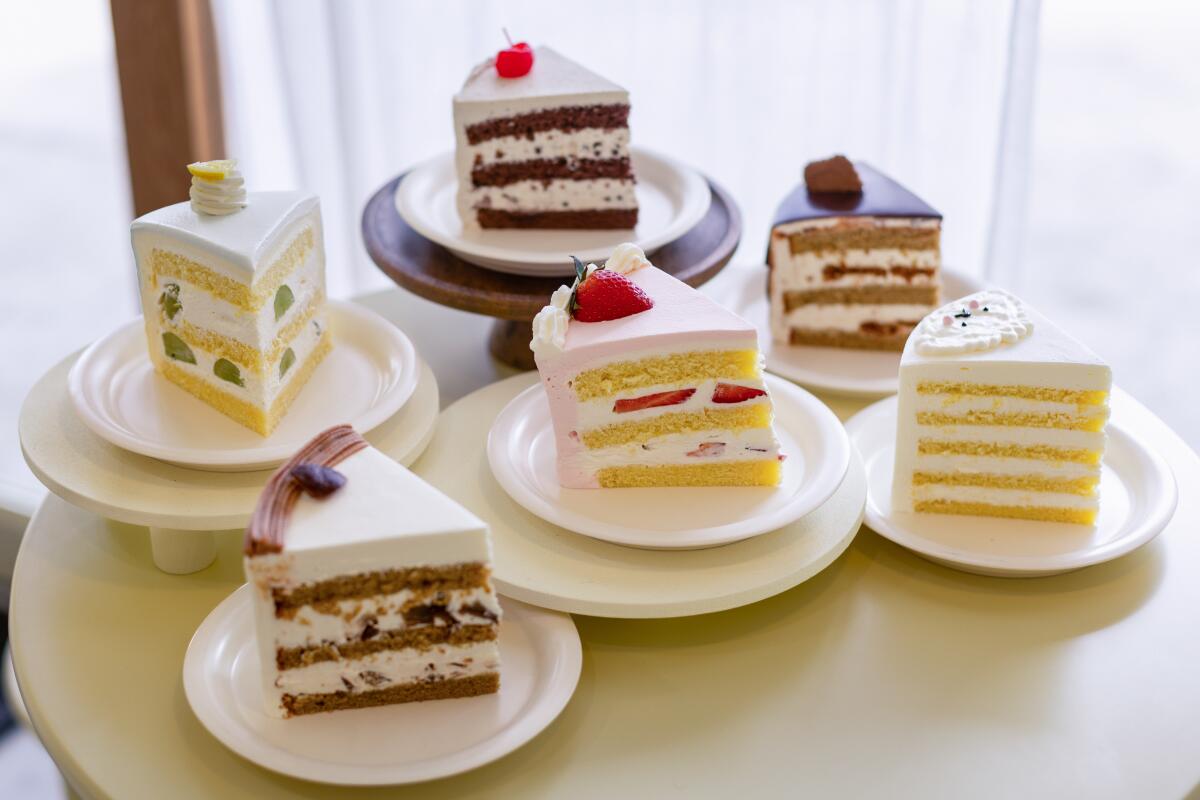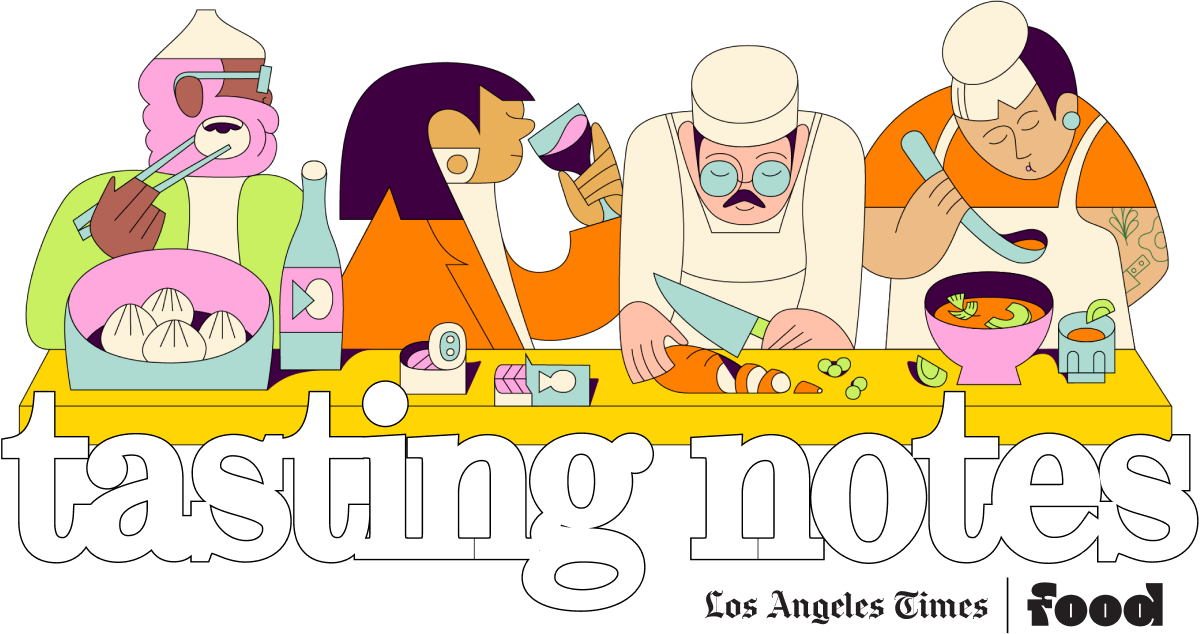If the world has gone digital, why do so many of us still want cookbooks?

- Share via
Still cookbook crazy in a digital world, plus the Koreatown bakery where fans wait up to two hours for cake, a new croissant contender, new brunch and lunch picks, and why a vegan restaurant will start serving meat. I’m Laurie Ochoa, general manager of L.A. Times Food, with this week’s Tasting Notes.
Get your cookbooks dirty

Can cookbooks survive in a world where so many of us look for recipes on websites, social media or YouTube channels?
Even though I have hundreds of cookbooks — so many that I have stacks on every step up the staircase in my front hall — I frequently find myself online looking for recipe ideas or basic cooking information.
But the experience often leaves me unsatisfied. I might get the basic information I was seeking, but it’s only when I slow down and page through an actual cookbook — lingering over the photos or line drawings, taking in the stories behind the pictures and recipes, absorbing whether the author is a forgiving or strict teacher — that I fully immerse myself in a cook’s world and discover new ideas and old traditions about how we eat. It’s also how I come across recipes I wouldn’t have thought to put into a search field.
I’m not alone in my cookbook obsession. Food memoirs and cookbooks are consistently among the strongest areas of the book industry.
“Cookbook sales in the U.S. grew 8% year-on-year between 2010 and 2020, with sales numbers boosted even further by the pandemic,” wrote Kate Gibbs in a 2022 story in the Guardian.
Of course, as Gibbs pointed out, many buyers don’t actually use their cookbooks as cookbooks. Her cookbook author grandmother, Margaret Fulton, would often examine the books fans had brought her to sign and then scold them: “You’ve never cooked from this book. Where are the splatters, the markings of the kitchen, the stuck-together pages?”
If you saw the batter-stained pages in my copy of “The Breakfast Book” by Marion Cunningham, you’d know that my family has made a thorough exploration of the pancakes loved in the mid-1980s by Cunningham, the woman who revived “The Fannie Farmer Cookbook.” Silver-dollar-sized Bridge Creek Heavenly Hots, lemon pancakes, Zeppelin pancakes (named for their lightness) and the buttermilk pancakes that became so much a part of our breakfast lives we only take the book out as a talisman of sorts when we make them because we long ago memorized the recipe.
A well-loved cookbook is a well-worn cookbook. We shouldn’t be afraid to get our cookbooks dirty.
You’re reading Tasting Notes
Our L.A. Times restaurant experts share insights and off-the-cuff takes on where they’re eating right now.
You may occasionally receive promotional content from the Los Angeles Times.

I got an up close look at beloved cookbooks and cookbook authors over the weekend at the L.A. Times Festival of Books. Ken Concepcion and Michelle Mungcal, owners of the downtown L.A. bookshop Now Serving, co-hosted a booth with L.A. Times Food and brought some terrific authors with devoted followers. Even though some of their books weren’t out yet, festival goers were excited to meet and get pre-orders in for the new “Kismet” cookbook from chefs Sara Kramer and Sarah Hymanson, Karla Vasquez‘ “SalviSoul,” and Ruth Reichl‘s new “The Paris Novel,” filled with some pretty enticing scenes set in some of France’s great restaurants. (By the way, the cookbook shop Kitchen Lingo is hosting a signing and conversation with me and Reichl on May 14 at the Art Theater in Long Beach.)
I asked Veggiekins website founder Remy Morimoto Park for one of her go-to recipes from her book “Sesame, Soy, Spice” and she named the scallion pesto. It’s a subrecipe made with miso, basil and green onions from her “very green beans” recipe. She says it’s great on pasta or anything else you’d use with pesto.
Rie McClenny named tonkatsu as her go-to recipe from her book “Make It Japanese.” “The great thing about it? After you make tonkatsu, if you have leftovers you can make katsu don,” she says, with the pork cutlets simmered in eggs and dashi and served over rice.
Elizabeth Poett said her go-to recipe from her “Ranch to Table” book is blueberry yogurt pancakes. When she showed off the pristine page, it looked like it was only missing a few batter splotches to break in the book.
Over at USC’s Ray Stark Family Theater, I moderated a conversation with France-based cooking teacher Rosa Jackson (“Niçoise: Market-Inspired Cooking From France’s Sunniest City”); chef, writer and magazine founder Klancy Miller (“For the Culture: Phenomenal Black Women and Femmes in Food: Interviews, Inspiration, and Recipes”), and “My Life in Recipes” author Joan Nathan, whose Passover Pecan Lemon Torte With Lemon Curd from the book was served with other Nathan dishes at a Seder Monday night hosted by Akasha Richmond at her Culver City restaurant Akasha.
Miller talked about how she wrote “For the Culture” as a book “that my younger self would have wanted to read. As I was coming up through culinary school I just didn’t have that many role models who looked liked me.” One of the chefs she discovered was Lena Richards. “She was a domestic cook in New Orleans ... [who] ended up owning her own cooking school. She had a TV show and published her own cookbook. She had a line of food. She was a traveling chef — I think of her kind of as a chef who did pop-ups all over the country. I just feel like, holy smokes! She was the blueprint. She had it all going on. And this was in Jim Crow South.”
On Sunday at the festival, “Koshersoul” author Michael Twitty and “Fieldwork” author and Michelin chef Iliana Regan had an impromptu conversation at the booth about the challenges of writing their very intimate memoirs.
“For me, one of the big challenges in writing my food-slash-personal-slash-cookbook memoir was the vulnerability,” Twitty said. “I went really deep into my emotions ... my family history. There’s a lot of personal stuff ... that comes up. So the biggest challenge is trying to figure out what stories to tell and what stories to hold close and not tell.”
“It was so complicated,” Regan agreed. “People have said to me, ‘Wow, you were so honest and so raw.’ If I was thinking about who was reading, I probably wouldn’t have written the things that I did. Going into things that are taboo. ... So for me [the challenge] was not letting it hold me back, thinking about my audience.”
Why a vegan restaurant will now serve meat

The choice to eat meat or to go vegan or vegetarian is highly personal. Some come to the decision primarily with the hope of preventing cruelty to animals. Others choose the diet for individual health reasons or for the environment.
Chef and farmer Mollie Engelhart, after specializing in serving vegan food at her Sage Vegan Bistro locations, made the risky decision to change the orientation of her restaurants in the name of regenerative agriculture. As Stephanie Breijo reported this week, she is renaming her restaurants Sage Regenerative Kitchen & Brewery and will add some meat dishes to the menu from animals raised using regenerative farming practices.
“The backlash on social media was swift,” Breijo wrote.
“It’s vulnerable to publicly say, ‘I believed one thing, and maybe I was wrong and now I believe something else,’” Engelhart told Breijo in an interview, “but I hope that it inspires people in their own lives to be willing to be open-minded when something else makes more sense to you.”
Consider the meatball

“Meatballs don’t always have to be meat,” writes Paola Briseño-Gonzalez in her latest story for L.A. Times Food. “Along the Mexican coast, you can find brighter variations of meatballs made with ground fish and shrimp that shatter your expectations of what albóndigas can be.” Briseño-Gonzalez describes some fantastic-sounding places along the Mexican coast that serve shrimp meatballs, including Albóndigas de Camarón Las Originales in Playas de Tijuana and tiny Makai in Punta Mita. Then she gives us a recipe she developed for brothy shrimp meatballs with Sungold tomatoes. A perfect spring soup.
Cakes of the moment

I’m thrilled that Khushbu Shah, whose cookbook “Amrikan: 125 Recipes from the Indian American Diaspora” comes out June 4, is our newest freelance contributor. In her first L.A. Times Food story, she takes us inside the world of Harucake, created by Ellie You, “a master of the Korean minimalist cake-decorating style popularized by bakeries throughout Korea, images from which have persistently flooded Instagram over the last couple of years.” Shah says lines for Harucake’s whole and sliced cakes on weekends can last up to two hours. And even on less-hectic weekdays the cakes tend to sell out. “In flavors such as Yogurt Green Grape, Strawberry Milk Cream and Lotus Mocha,” Shah writes, “[the cakes], made from layers of fluffy génoise sponge and frosted with airy milk cream ... hit that ‘not too sweet’ sugar level deeply prized.”

And if you’re looking for more bakery lines, Stephanie Breijo waited her turn at Fondry, Eagle Rock’s new pâtisserie, the newest contender for “L.A.’s most sought-after croissants.”
Have a question?
Also ...
- Restaurant critic Bill Addison went through his most recent 101 Best L.A. Restaurants guide and made a list of 16 Southern California brunch favorites from Calabasas to Long Beach.
- And assistant Food editor Danielle Dorsey worked with our Food team to update our list of 28 of the best lunch restaurants in L.A.
- Ashley Ahn reports that food recalls have reached the highest level since the pandemic, with undeclared allergens seen as the biggest reason for the rise.
Eat your way across L.A.
Like what you're reading? Sign up to get it in your inbox every week.
You may occasionally receive promotional content from the Los Angeles Times.

Eat your way across L.A.
Get our weekly Tasting Notes newsletter for reviews, news and more.
You may occasionally receive promotional content from the Los Angeles Times.




